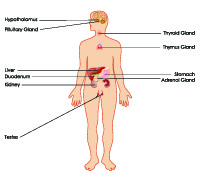Welcome back to another episode of The Slightly Greener Life!
If you have followed me for a while, you’ve probably heard me talk about endocrine disruptors.
You have probably also heard the term when it comes to household personal care and beauty products, or you might have heard them called by other names, such as “hormone disruptors.”
I feel like these are such a big part of the chemicals that we should avoid, and a lot of the toxic chemicals we’ll be talking about will fall into this category of hormone (or hormone) disrupting chemicals.
We’ll talk more about specific ones in future episodes, but today I thought I would give you a high-level overview of what these chemicals are and what they do, so when I say endocrine disruptors in future episodes, you’ll have an understanding of what I’m talking about.
I also want to say real quick, some of this information can be so scary at first. And it’s so frustrating, knowing that these chemicals are in – and are allowed in – many of our everyday products.
But just take a deep breath – the good news is that you’re already taking control of your health. Just by listening to this podcast and learning this information, you’re empowering yourself to be an educated consumer.
Ok, with all that being said, let’s dig in!
Before we get into what endocrine disruptors are, let’s talk about the endocrine system and what it does.
What Does the Endocrine System Do?
The endocrine system is where our body’s hormones are made, stored, and secreted. Hormones are our body’s messengers.
The endocrine system consists of eight glands: the thyroid, pituitary gland, hypothalamus, pineal gland, adrenal glands, pancreas, ovaries, and testes.

There are hormones for everything in our body (not just what we blame when we’re crabby!).
There are hormones for sleep, appetite, sleep cycles, mood, blood sugar, heart rate, thyroid, fertility, blood pressure, metabolism, and for the immune system, just to name a few.
What Endocrine Disruptors Do
An endocrine disruptor is a man-made chemical or substance that interferes with the function of the endocrine system. It can do this several ways by:
- Imitating hormones
- Blocking hormones and preventing them from doing their job
- Producing or secreting hormones when they’re not needed
- Causing an over- or under-production of hormones
So if you can imagine a synthetic, man-made chemical imitating or getting in the way of a hormone trying to do its job, you can see where these health issues can crop up.
And this is so important, because the endocrine system regulates EVERY function of the body.
Health Effects of Endocrine Disruptors
Endocrine disruptors are linked to health effects such as weight gain, insulin resistance, diabetes, allergies, asthma, cardiovascular disease, fertility issues, thyroid problems, increased cancer risk, and even neurodevelopmental disorders (such as ADHD, learning disabilities, and autism), and lower IQ, and can even affect things such as hunger, mood, and sleep.
How Hormone Disruptors Affect Kids
And endocrine disruptors affect all of us, but remember that children are especially vulnerable to the health effects of toxic chemicals – they’re skin is thinner, which can allow more penetration of chemicals, pound for pound they breathe more air, drink more fluids, and eat more food than an adult, and they’re more closely tied to their environment – smaller children crawl on the floor and stick fingers and just about anything else they can get their little hands on.
And their detoxification pathways are not as developed or as efficient as an adult’s is – meaning they cannot detoxify and get rid of the chemicals as quickly, leaving them in the body for a longer period of time.
Not to mention, there are critical times during development where you definitely don’t want an endocrine-disrupting chemical to interfere with a child’s growth and development.
Ok so those are pretty scary facts, right?
But remember, I’m telling you all of this because there are solutions, and at the end of this episode I’ll be giving you some ways to start avoiding some of these endocrine disruptors today.
Where are Endocrine Disruptors Found?
Unfortunately, in just about everything many products we’re exposed to every day! They can be lurking in everything from your food to your personal care and beauty products, and even in medicine.
The good news is that you can greatly reduce your exposure if you know what to be on the lookout for.
Some common endocrine disruptors include:
- Phthalates
- Parabens
- Flame retardant chemicals
- BPA
- Triclosan (an antibacterial)
- Water, grease, and stain-resistant items
- Teflon and non-stick pan coatings
Here are some common endocrine disruptors, and where they’re found:
Phthalates and other plasticizers
- Vinyl shower curtains and flooring
- Scented items – air fresheners, cleaners, cosmetics, laundry detergents, shampoos & shaving creams, just to name a few
- Plastic food storage containers
- Soft vinyl bath toys
- Nail polish
PFAs (Used to make products stain-resistant, waterproof, or non-stick).
- Non-stick cookware
- Pizza bags
- Microwave popcorn bag linings
- Cosmetics
Bisphenol A (BPA)
- Store, bank, and gas station receipts
- Water bottles (even those labeled BPA-free)
- Canned foods (such as) soups and canned tomatoes
Parabens
- Personal care products such as hair products, body wash, lotion, deodorant, shave creams, and anti-aging moisturizers
- Cosmetics, such as eyeshadow, lipstick, foundations, and chapstick.
- Look for propylparaben, ethylparaben, or butylparaben, which are ones commonly used in cosmetics
- even snack foods and be sure to check labels – ingredients can change quickly!)
Flame Retardants
- Furniture, such as polyurethane foam products (mattresses, upholstered furniture, pillows, etc.)
- Flame-resistant clothing, such as infant and toddler pajamas
- Electronics
- Building foam insulation
- Soda
Triclosan
- Antibacterial products, such as hand sanitizer
- Household products, such as cutting boards (look for the brand name Microban) and dishwashing liquids
- Personal care products, such as deodorant and toothpaste
- Antibacterial clothing, such as some sock brands
Dust
Another place where endocrine disruptors are commonly found in the home? Household dust! A study has found that dust is the one of the biggest exposure to flame retardant chemicals. And it also harbors phthalates, lead, and other toxicants. Be sure to damp mop (dry mopping can spread dust) and dust frequently to keep household dust at bay, especially in the areas where your children spend the most time.
Babies and toddlers like to spend a lot of time on the floor, so hit these places the hardest. Vacuuming carpets and floors with a HEPA filter will also help to reduce exposure.
How to Avoid Endocrine Disruptors
- Avoid products with the words “fragrance” or “perfume.”
- Look for products that say “phthalate-free,” “scented only with essential oils,” or “no synthetic fragrance.”
- Buy organic produce, meat, and dairy as much as possible because some pesticides contain hormone-disrupting chemicals
- Avoid using scented candles, or plug-in air fresheners. Diffuse essential oils or use a safer brand of candle (like Pure Plant Home or Fontana candles).
- Don’t use non-stick cookware.
- Store food in glass storage containers, rather than plastic.
- Look for nail polish that says “phthalate-free.” (I have a list of some of these in the podcast notes on my website)
- Buy furniture and electronics that don’t contain flame retardants, and repair torn upholstery.
Dust and vacuum the places where your family spends the most time a few times a week, if not daily.
What to Do Next
That was a lot today, but so many of the chemicals that we come into contact every day can affect our hormones. But now that you know what to be on the lookout for, it will be easier to avoid them and reduce your exposure.
As you learn this information, it’s easy to freak out as we think “oh no, I use that product on my kids and it’s not safe,” or “I have plug-in air fresheners all over my house.”
Don’t freak out. We do the best we can with the information we have. And you might not have had this information before. But now you have more control – you know how to start replacing toxic products with cleaner versions.
And don’t forget to grab these tips and start avoiding endocrine disrupting chemicals today by downloading the cheat sheet here.
Thank you so much for joining me today, and I’ll see you in the next episode!
Did you find this podcast episode helpful? Please subscribe/follow on your favorite podcast platform so you don’t miss an episode! Or you can listen on my website here.
Links:
Grab the free cheat sheet: How to Avoid Endocrine Disruptors
Listen to The Slightly Greener Life on Apple podcasts, Spotify, and mor
Listen to The Slightly Greener Life on my website
The Slightly Greener Method Book
Slightly Greener Living membership

